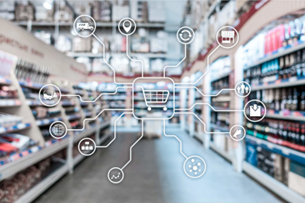Digital Transformation is an Opportunity of Historic Proportions
Software in The Evolving World
When Marc Andreesen published his article in the Wall Street Journal in August 2011 on “Why Software Is Eating The World,” most traditional leaders found it hard to equate what was happening with Amazon, Pixar, Apple, or Netflix with the future of their own companies. That was understandable.
As Bill Gates said famously, “We always overestimate the change that will occur in the next two years and underestimate the change that will occur in the next ten.”
It hasn’t been 10 years yet since the publishing of Andreesen’s article, but his meaning is now suddenly clear. Digital disruption isn’t just for the tech or media or entertainment industries alone. It is so widely accepted that software will disrupt every industry that newspaper articles now list which industries have been least disrupted. And even those are scraping the bottom of the barrel when they list Government and Judiciary as being relatively untouched by digital disruption.
All that industrial transformation is an opportunity of historic proportions. Software is eating the world, not in a destructive pac-man way, but more in the manner of plants that consume carbon dioxide and light to generate oxygen. We see signs of this digital photosynthesis all around us. Digital is multiplying the capabilities of all other disruptors, whether nanotech or drones, or solar. Examples of these abound. The sheer breadth of what’s possible today and how quickly it changes is breathtaking.
I share a tiny percentage of such examples below.
- Five of the top 10 companies in the world by market capitalization in 2018, per PWC, are Technology companies. And that doesn’t include Amazon or Alibaba which are classified as “consumer services”.
- Eight years ago, only one of these ten, Microsoft, was on the Top 10 list.
- Autonomous vehicles which seemed like science fiction only a few years ago, will account for about $50 Billion in sales by 2035. The children being born today may never need to apply for a driver’s license.
- Warehousing, which used to be a heavily manual operation, is now significantly automated. Gone are the days when a human picker went to the toothbrush, deodorant, and lipstick aisle to fulfill your online order for these three products. Today, instead of the picker moving to the aisles, robots move the aisles to the stationary picker.
- Additive manufacturing, like 3D printing, will account for 10% of all manufacturing in the next 10 years. China has already 3D printed a 6-story building. The Space Station has been printing tools and spare parts for itself for years now.
- Software algorithm-based supply chain planning will dramatically shrink the product inventories and lead times in supply chains. The fashion retailer, Zara, has been delivering fashion from designer ideas to retail stock within two weeks for several years now.
- Agile, custom-built manufacturing will slowly replace large-scale “batch” manufacturing. Chinese smartphone manufacturer Xiaomi already ships new batches of phones every week, with each batch having superior capabilities to the last. They also register 70% of their sales online, including pre-orders, which allows them to purchase raw material only after sales have been placed.
- Nearly 40% of all financial services sector jobs could be done by software robots in 2030.
- Between 40-50% of jobs in the manufacturing, transportation, and retail sectors could be done by hardware or software robots by 2030.
- Even robots in manufacturing will be disrupted in the next 10 years, as 3D printing takes over. If you can print your PC or smartphone at home, you eliminate robots in the factory.
- Average pretax income in these sectors would rise due to these productivity gains, although perhaps not equally spread between all groups of workers.
- Wealth management advice fueled by Artificial Intelligence (AI) will explode over the next few years. By 2025, 10% of all wealth being managed will use a combination of AI and humans. Of that, 16% of that will be managed only by robots.
- Certain news agencies already generate 90% of their short, pro-forma real-time news updates on sports and financial markets using software robots. AI, with some human journalist help, will generate 90% of all news in 15 years.
- Voice recognition is already 3 times faster and more accurate than typing. In the future, Natural Language Processing bots will understand and execute most of the day-to-day tasks at home and at work.
- Ambient computing will explode. It is the trend of pervasively embedding computers into everyday devices to the extent that we stop thinking of computers as individual boxes.
- Deep Learning, a cutting-edge sub-set of AI which is used in self-driving cars, will also be used to self-generate cryptographic algorithms to communicate between devices that are extremely difficult to hack.
- Deep Learning can already read your lips with more than 90% accuracy, while the average lip reader usually delivers 50% accuracy.
- If Deep Learning can figure out how to play computer games without being taught or programmed, then AI-driven product development for R&D departments is already within reach.
- The Gig Economy – the trend of part-time or temporary employment “gigs” – accounted for about 10% of the US workforce in 2005. It is already a third of the workforce today and exceeded 40% by 2020. You can win big by leveraging this trend.
- 32 million people in the US cannot read a road sign, but in a handful of years we project to have 10 million self-driving cars that will accurately read all signs.
- By 2027, machine literacy – the ability for computers to be above basic human literacy levels, will exceed that of 24 million US people.
- 90% of the global population above the age of 6 has a cell phone.
- 1.2 billion Indians will have smartphones (not just cell phones) by 2030. And this is in a country where even land-lines were a rarity just 30 years ago.
- Studies have consistently proved that digital technologies are narrowing the education gap in developing nations. Add that to the 90% global cell phone ownership levels among the >6-year olds in 2020, and you have a dramatically different consumer profile to market to.
- In 20 to 30 years, the cost of producing energy at home will be a fraction of the cost of buying it off the grid.
- More importantly, it’s the consequences of cheap electricity that are more exciting. Cheap electricity means cheap drinking water, as energy allows you to process all kinds of water including sea water.
- Dozens of new battery technologies ranging from bio-energy to graphene and micro-supercapacitors will pump new life into the traditional Li-Ion battery technology. Medium-term, technologies like Lithium-Air, Lithium-Sulphur, and Vanadium Flow will likely get us to a fully renewable future in 20 years.
- Improvements in healthcare mean that the average American male lifespan in 2050 could be 83-85 years. For women, it would be 89 to 94 years.
- Soon we will see human trials of surgical nanobots. These tiny robots can capture individual cells, drill, coordinate with each other, deliver targeted medicine and purge themselves when the job is complete.
- Medical diagnostics will become a self-serve industry, as smartphone extensions will allow patients to diagnose everything from AFib (atrial fibrillation of the heart) to genetic disorders right at home.
- In the next 5 years, there will be apps that can tell by your facial expression if you’re lying. Imagine what that could do to the judicial system!
- Smart cities will use sensors and digital capabilities to manage traffic, utilities, law enforcement, medical support, and other community services. There are already more than 250 smart city projects in the world today.
- India has a plan to build 100 smart cities.
- Lab-grown cultured meat will deliver superior alternatives to conventional meat, using 50% less energy and 80-90% fewer emissions. That’s good because the meat industry accounts for 18% of all our greenhouse gas emissions.
- Robots and drones are likely to be the farmworkers of the future, including in small in medium-sized farms. Robots can be made for $500 in developing markets already, and this price tag will quickly fall below the $100 level.
- Virtual bartenders are already in use. Royal Caribbean’s cruise ship, Anthem of the Seas mixes your cocktails and allows you to go beyond the menu to create your own cocktails.
- Blockchain, currently the only technology claimed to be incorruptible, may finally give us secure online voting.
- Blockchain will disrupt the need for middlemen to complete financial transactions. According to the World Economic Forum, 10% of the global GDP will be conducted over blockchain by 2025.
- A combination of full trust capability, transparency, and security will turn the manufacturing Supply Chains of the future into Demand Chains.
- In developing markets, the use of low-cost blockchains will help address endemic institutional weaknesses. Examples include expanding the sharing economy to enhance local bargaining power, growing micro-financing, attacking middleman-based corruption, and delivering secure identity and ownership documents.
- Over the next decade, modern manufacturing in the US will create 3.5 million new jobs. The big challenge will be to retrain existing workers, more than threats from globalization. Up to 2 million high-tech manufacturing jobs may go unfilled.
- Spending on digital advertising in the US has already overtaken TV advertising in 2017. Corporate Advertising functions will evolve to become data and algorithm-driven, personalized customer engagement functions.
- The Corporate HR function will need a makeover, to evolve away from delivering policies, processes, and talent management services. Those will be automated using HR Tech. HR will evolve into delivering innovative, agile, digitally-savvy human capital.
The Truth about Digital Transformation
There is no aspect of enterprise operations or personal life which is not being affected by digital technology. This is an opportunity of immense proportions. Even better, you don’t need to be a technology expert to benefit from this trend. You simply need to understand how and where your current profession or personal situation can leverage digital transformation.
What Should You Do?
It is proven that digital disruption is unavoidable. As times continue to change, so will the variety of software changes and technologies that are being introduced to us every day. Digital transformation is becoming more and more advanced and getting harder to ignore. What does this mean?
Get ahead of the game. In the next decade, digital transformation will have affected almost 100% of the business world in some way or another. Use these facts to your advantage and become educated in the upcoming technologies that are evolving. It is the perfect time to get ahead of competitors early. Remember, change is good!
This is an excerpt by Tony Saldanha from his best-selling book, “Why Digital Transformations Fail.”




